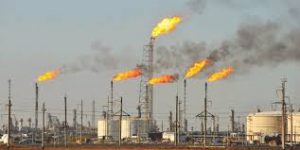
Oil companies are burning a record amount of natural gas instead moving it to market and selling it, according to a new report from the U.S. Energy Information Administration.
The volume of U.S. natural gas reported as vented and flared reached its highest-ever average annual level of 1.28B cf/day in 2018, the EIA says, adding that the percentage of gas vented and flared rose to 1.25% from 0.84% in 2017.
At the current market price of $2.41/MMBtu, ~$1.1B worth of natural gas was wasted during the year.
Texas and North Dakota accounted for 51% and 31%, respectively, of the total U.S. vented and flared natural gas.
Pipeline operator Williams recently filed an anti-flaring lawsuit against the Texas Railroad Commission, arguing the state agency grants flaring permits too easily instead of requiring oil producers to move it to market.
The volume of U.S. natural gas that was reported as vented and flared reached its highest average annual level of 1.28 billion cubic feet per day (Bcf/d) in 2018, according to the U.S. Energy Information Administration’s Natural Gas Annual, which contains updated data about vented and flared natural gas. In 2018, the percentage of U.S. natural gas that was vented and flared increased to 1.25% of gross withdrawals, up from 0.84% the previous year. Two states, North Dakota and Texas, accounted for 1.1 Bcf/d, or 82% of the reported U.S. vented and flared natural gas.
Natural gas flaring is the process of combusting natural gas at the wellhead using a dedicated flare. Venting refers to the direct release of gas into the atmosphere and is often banned or restricted in certain states. When possible, flaring is preferred because methane, the main component of natural gas, is a potent greenhouse gas, more potent than the carbon dioxide that is the main product of flaring. Although flaring is more common than venting, both of these activities routinely occur during oil and natural gas development.
As crude oil production has outpaced the buildout of infrastructure to handle natural gas, associated gas—or natural gas that is extracted during oil production—has been increasingly vented and flared in order to manage this undeliverable natural gas production from flowing oil wells. State agencies are largely responsible for regulating natural gas venting and flaring by imposing restrictions and natural gas capture requirements.
In 2018, Texas and North Dakota accounted for 51% and 31%, respectively, of the total U.S. vented and flared natural gas. Both Texas and North Dakota are working with producers to limit the need for flaring without shutting down or affecting production of crude oil from new wells. Venting is banned in North Dakota and restricted in Texas.
The Bakken play in North Dakota is one of the most prolific crude oil producing areas in the United States, where production grew five-fold between 2010 and 2018 to reach about 1.5 million barrels per day. During this time, natural gas processing plant capacity has not kept pace with the amount of associated gas being produced from oil wells. In 2018, North Dakota flared 0.40 Bcf/d, which is 17% of total natural gas gross withdrawals in North Dakota and the highest percentage share of any state.
In 2014, the North Dakota Industrial Commission established Order No. 24665 to reduce the amount of flared natural gas, but the current targets have not been consistently met. Expected completions of natural gas processing plant projects would increase the amount of natural gas that operators could capture, as would additional capacity on interstate pipelines to move the processed natural gas to market and reduce the amount of natural gas that is flared.
In Texas, the Permian Basin and Eagle Ford plays have contributed to a rapid increase in the natural gas flaring in recent years. In 2018, vented and flared natural gas in Texas reached over 0.65 Bcf/d, nearly double the 2017 level and about 2.5% of total 2018 natural gas gross withdrawals in the state.
The majority of flaring permits received by the Texas Railroad Commission are for flaring casing-head gas from oil wells. Wells are permitted to flare for up to 10 days after completion to test for a well’s resource potential, but extensions may be granted while operators await connecting wells to natural gas gathering lines. The number of venting and flaring permits approved by RRC increased from slightly more than 300 in fiscal year (FY) 2010 to nearly 5,500 in FY 2018. A number of new natural gas pipelines are planned or under construction to transport greater volumes of natural gas to market, particularly from the Permian Basin.
Source: Seeking Alpha







